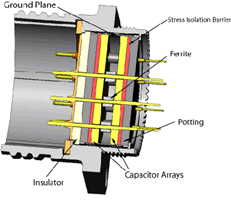Filtered Connectors Cut the Clutter
A variety of filtered connectors can help eliminate unwanted noise
 The world has become an electronically noisy place as devices that range from weather radar to garage door openers flood the airwaves with electronic noise. Digital devices must be able to identify a pattern of ones and zeros among a rising tide of random electronic noise. As system speeds increased, the voltage levels of data signals have been reduced. Similar to hearing a whisper at a football game, the ability to discriminate low signal levels embedded in high levels of noise has a major influence on the signal integrity of electronic systems.
The world has become an electronically noisy place as devices that range from weather radar to garage door openers flood the airwaves with electronic noise. Digital devices must be able to identify a pattern of ones and zeros among a rising tide of random electronic noise. As system speeds increased, the voltage levels of data signals have been reduced. Similar to hearing a whisper at a football game, the ability to discriminate low signal levels embedded in high levels of noise has a major influence on the signal integrity of electronic systems.
The ability of an electronic device to operate properly within its intended environment is known as electromagnetic compatibility (EMC). Achieving EMC involves both addressing emission of harmful energy as well as managing susceptibility or immunity to electromagnetic interference (EMI). The continuing trend of physically shrinking systems often results in strong sources of EMI in close proximity to sensitive receivers. Concern about product failure due to the proliferation of electronic devices resulted in a series of RF emission and susceptibility regulations generated by agencies including: the FCC, U.S. military, IEC, ISO, and CISPR.
Unwanted noise can be induced in electronic circuits via radiated or conducted paths. Isolating circuits from radiated noise can be accomplished by providing a barrier between the source and victim. A metallic shield applied to the exterior of a cable or enclosure can reduce radiated EMI to acceptable levels. The effectiveness of a shield is highly dependent on the choice of materials, the size of any apertures, and grounding design.
Unshielded copper cables passing through external electric and magnetic fields will have noise impressed on the signals which can enter the box via power inlet and input/output connectors. One of the most effective solutions to minimizing conducted signal distortion from external EMI is the insertion of a filter in the circuit.
A Variety of Filter Technologies Can Address Noise
 Applications that require a high degree of noise isolation utilize a variety of filter technologies that incorporate passive elements of capacitance and inductance. These devices are broadly identified as low-, high-, or band-pass filters, meaning that they allow lower, higher, or a narrow band of desired frequencies to pass through the circuit with a minimal reduction in signal strength while simultaneously blocking unwanted frequencies.
Applications that require a high degree of noise isolation utilize a variety of filter technologies that incorporate passive elements of capacitance and inductance. These devices are broadly identified as low-, high-, or band-pass filters, meaning that they allow lower, higher, or a narrow band of desired frequencies to pass through the circuit with a minimal reduction in signal strength while simultaneously blocking unwanted frequencies.
 A low-pass filter, for instance, achieves this by essentially becoming a frequency dependent resistor connected between the signal lines and ground. Lower frequencies pass through while higher frequencies are attenuated.
A low-pass filter, for instance, achieves this by essentially becoming a frequency dependent resistor connected between the signal lines and ground. Lower frequencies pass through while higher frequencies are attenuated.
Individual chip capacitors can be placed on a printed circuit board to filter incoming lines, but the fact that these higher-order frequencies have already entered the EMI shielded enclosure provides an opportunity for them to radiate to sensitive internal circuits.
 The most effective solution is to prevent EMI from entering the box, which is achieved by installing a filter within the bulkhead-mounted connector. Placing filters within connectors results in much more efficient use of valuable PCB space and reduces the discrete component count.
The most effective solution is to prevent EMI from entering the box, which is achieved by installing a filter within the bulkhead-mounted connector. Placing filters within connectors results in much more efficient use of valuable PCB space and reduces the discrete component count.
Custom Configurations Target Specific Circuits
In addition to the integration of discrete chip capacitors, filtered connectors may use a combination of tubular or planar capacitors, as well as inductive ferrite beads, to create highly customized configurations and achieve a specific filtering bandwidth profile. A variety of filter types are designed to maximize performance in specific circuits.

 A key advantage of filtered connectors is that the connector inserts include a ground plane, which effectively seals the connector mounting hole that would otherwise allow radiated EMI to contaminate the system. The chassis-attached metal shell of the connector and insert provides a low impedance path to ground and prevents EMI from radiating in or out of a shielded enclosure.
A key advantage of filtered connectors is that the connector inserts include a ground plane, which effectively seals the connector mounting hole that would otherwise allow radiated EMI to contaminate the system. The chassis-attached metal shell of the connector and insert provides a low impedance path to ground and prevents EMI from radiating in or out of a shielded enclosure.
Filtered connectors have been adapted over the years to just about every pluggable interface, but some have found applications in select markets and are now considered de facto standards. D-Subminiature connectors utilizing a variety of filter technologies, including individual chip capacitors and inductors, remain one of the most common interfaces used in commercial and military applications.
 The defense and aerospace connector markets have traditionally generated the most fertile applications for filtered connectors. The mission-critical nature of equipment in this market segment makes filtered connectors a key element in system design.
The defense and aerospace connector markets have traditionally generated the most fertile applications for filtered connectors. The mission-critical nature of equipment in this market segment makes filtered connectors a key element in system design.
Standard military connector inserts are modified with custom filter assemblies to provide the required isolation for specific applications. Common filtered circular connectors include MIL-DTL-38999, -26482, and -83723, as well as the military version of the D-Subminiature MIL-DTL-24308. The avionics industry has used filtered ARINC 404/600 connectors for many years, and they are available in a large variety of configurations. Filtered connectors that provide suppression of electrostatic discharge (ESD) are also available.
Several Suppliers Comprise a Fragmented Market
Broad market use of filtered connectors has been limited by their relatively high cost, but less effective, lower-cost alternative solutions, such as PCB mounted chip capacitors, have produced acceptable performance in many applications. The custom nature of filtered connectors tends to result in a low-volume, high-mix product line. Filtered connectors often consist of hand-assembled, highly customized filter elements that require precision soldering and extensive performance testing, which contributes to a high piece price. The need to obtain prototype custom filtered connectors can also significantly delay a new product development cycle.
The market for filtered connectors is shared among several large suppliers, including: Amphenol, Glenair, Radiall, Smiths Interconnect, and API Technologies (Spectrum Control), in addition to approximately 60 smaller players, resulting in a highly fragmented market. Suppliers have improved their assembly and test verification processes to reduce the historically long lead times, but the combination of high cost and limited design flexibility remain barriers to broad market usage.
That may change as sensitive circuits proliferate in high-volume products. The autonomous transportation market, in which multiple high-speed data streams must be analyzed in real-time with absolute reliability, may represent a major new opportunity for filtered connectors in commercial applications. The growth of portable consumer medical equipment may also offer new high-volume applications for the use of connectors with integrated filtered and ESD features.
- Optics Outpace Copper at OFC 2024 - April 16, 2024
- Digital Lighting Enhances your Theatrical Experience - March 5, 2024
- DesignCon 2024 in Review - February 13, 2024





